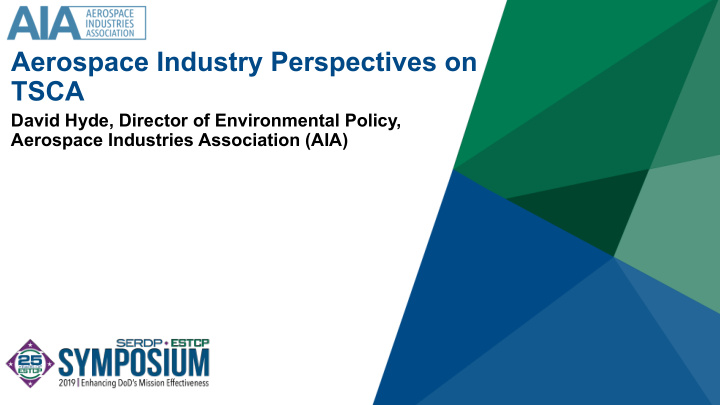



Insert Logo Here Aerospace Industry Perspectives on TSCA David Hyde, Director of Environmental Policy, Aerospace Industries Association (AIA) Insert Logo Here #SerdpEstcp2019
What does AIA do? • Represents approximately 330 members from across the aerospace and defense industry, who employ almost 900,000 people in the U.S. • Our Mission: To advocate for policies and investments that keep our country strong, bolster our capacity to innovate and spur economic growth. • Our Vision: To help our united membership improve the safety of air transportation, make America more secure, fuel exploration, drive innovation and ensure a vibrant industrial base. • The voice of American aerospace and defense Insert Logo Here 2 #SerdpEstcp2019
Chemical usage in the aerospace and defense industry • Aerospace products operate under range of extreme environmental conditions • e.g. extreme temperatures, speeds, pressures, corrosion resistance • To ensure products meet safety, reliability, and durability requirements, performance is dictated by a range of federal, military, industry and company specifications • Possibility of significant disruption if a chemical can no longer be used • In many cases an approved drop-in replacement is not available • In these instances, need to work with chemical formulators to research and reformulate a product which gives the same performance requirements • Testing, reformulating and certification/approval can take many years • No guarantee of success Insert Logo Here 3 #SerdpEstcp2019
Other issues facing aerospace sector • Even if aerospace uses are not restricted, typically very low-volume and highly-specialized uses • May not be viable for chemical producers to continue to manufacture • Aerospace goods and supply chain extremely complex • May not know all uses of substances throughout the supply chain • Long-life cycle of aerospace and defense products – often several decades • Access to chemicals still required for replacement and maintenance for many years after product is sold • Long lead-in times for product redesign Insert Logo Here 4 #SerdpEstcp2019
AIA Chemicals Activity • AIA Chemicals Subcommittee reports to Environmental Committee • Currently 30 active companies involved • Monitor, respond to, and develop strategies related to national and international chemical regulations impacting the aerospace and defense industry • AIA supports evidence and risk-based chemicals regulation • Work closely with Rapid Response Network • Network of member companies • Identifies uses of chemicals subject to proposed regulation • Allows industry assess potential impacts of chemical restriction/ban Insert Logo Here 5 #SerdpEstcp2019
AIA Views on TSCA • Supports the risk-based approach required under TSCA • Process so far has been able to accommodate unique characteristics of aerospace goods and chemical uses of industry. BUT • TSCA does pose challenges for industry…. Insert Logo Here 6 #SerdpEstcp2019
Industry’s TSCA challenges • TSCA process requires significant resources for industry • Large number of substances going through process • Understanding uses throughout supply chain can be difficult and opaque • TSCA is just one of many global chemical frameworks • Process creates uncertainty for industry about how future chemicals under TSCA will be treated • Industry would prefer more certainty about what are unacceptable risks and when restrictions are necessary • At present, not clear when or why EPA might impose restriction and difficult for industry to prioritize Insert Logo Here 7 #SerdpEstcp2019
Reducing uncertainty for industry • A framework the EPA should follow for determining whether a particular use creates an unacceptable risk would help make the process more transparent and predictable for industry • Only those uses which pose an unacceptable risk should be regulated • Applying exemption to replacement parts as default where no significant risk posed would be consistent with TSCA Insert Logo Here 8 #SerdpEstcp2019
EXAMPLES OF TSCA ISSUES Insert Logo Here 9 #SerdpEstcp2019
Example 1: 1,3 Butadiene • In 2014, the EPA’s report Flame Retardant Alternatives for Hexabromocyclododecane (HBCD) recommended a butadiene styrene brominated copolymer as a safer alternative for HBCD. • HBCD designated as a high priority chemical in 2016, draft risk evaluation in June 2019 found no unreasonable risk to population, consumers, workers, or the environment. • 1, 3 Butadiene given proposed designation as a high priority chemical in August 2019 and if this designation is confirmed will undergo risk assessment • If industry had acted to replace HBCD uses as per guidance, could now have applications that could potentially be impacted Insert Logo Here 10 #SerdpEstcp2019
Example 2: Persistent, Bioaccumulative, and Toxic Chemicals • Industry welcomed EPA’s recognition that it was not practicable to regulate several aerospace uses of DecaBDE or PIP(3:1) • Recognizes industry commitment to phasing out DecaBDE and includes exemption for replacement parts • Includes exemption for PIP(3:1) used in aviation hydraulic fluids, lubricants, greases • However, AIA identified additional PIP(3:1) uses and likely others industry is not yet aware of and requested exemption for new and replacement aerospace parts • These would not be expected to cause unacceptable risk or be released to environment Insert Logo Here 11 #SerdpEstcp2019
THANK YOU Insert Logo Here 12 #SerdpEstcp2019
Recommend
More recommend